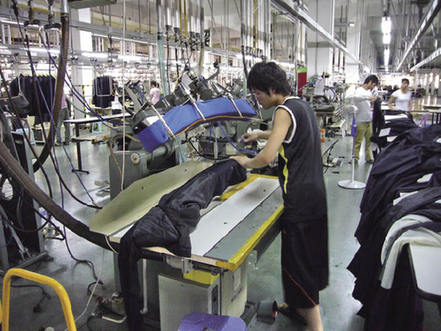| Garment Industry Picking Up
By special correspondent TAN XINGYU
 |
|
Fapai is one of the largest garment enterprises in Wenzhou. |
THOUGH Wenzhou's garment industry is not as reliant on exports as that of the Pearl River Delta, the cold winds of the global financial crisis are still felt keenly by local manufacturers, according to Zheng Chen'ai, chairman of the Wenzhou Fashion Association. He cited the extreme example of three closedowns within one day late last year in Ouhai District, a cluster of Western suit producers. Only few months later, in March, Wenzhou turned it around, with garment and accessory exports amounting to US $78.78 million, an increase of 32.26 percent over the same month last year and 114 percent over February 2009.
The garment industry is one of the largest in Wenzhou, and its manufacturers number more than 2,500, including 290 large ones. In 2008 its output value exceeded RMB 40 billion, and exports reached US $1.229 billion.
Low End, High End
"Most of the partial closedowns and bankruptcy cases were small operations, or medium-sized enterprises incapable of R & D and relying solely on purchase orders," says Chairman Zheng.
According to Mr. Zheng, the slowdown actually started in 2003, and the current difficulties are more a result of the innate weaknesses and defects of the garment industry than the consequences of the financial crisis. For one thing, the city's development environment for its garment industry is not favorable, suffering as it does from chronic shortages of land resources, capital and policy support. For another, there is no large, specialized wholesale market within the city for its numerous small and medium-sized manufacturers, who lack their own marketing channels. Many of them must rely on garment wholesale markets in Zhejiang's Keqiao Town and Yiwu City.
Mr. Zheng pinpoints the weak competitiveness of these enterprises and an immature industrial structure as the key problems of the local garment industry. "Eighty-five percent of the local manufacturers are at the low end of the production chain and sustain operations by simple order processing, a low status that leaves them vulnerable to external economic forces."
However, Cai Huantian, chairman of the association's foreign trade branch, showed us the other side of the coin. Wenzhou's garment manufacturers are, in fact, skilled in processing high-end products. Many of the world's best known brands, such as Versace and Armani, have their lines manufactured cost-effectively in Wenzhou without sacrificing their quality standards. "Wenzhou-made shoes and garments sell well in the United States," he says.
A positive side to the economic slowdown is that the government has adopted a more proactive policy to support the garment and other conventional industries.
In the past, garment businesses had great difficulty securing bank loans, but now the government has showed an increasing interest in easing access. The industry is a major source of jobs. Early this year, the State Council issued its adjustment and recovery plan for China's textile industry, proposing to coordinate the penetration of both international and domestic markets, boost technological upgrading, encourage the development of domestic brands, and optimize industrial structure. It also stepped up financial support and raised, once again, the export tax rebate for textiles and garments from 14 percent to 15 percent. It is estimated that the continuous rebate increase – from 11 percent in 2008 to current 15 percent – will result in an extra RMB 330 million for Wenzhou's garment industry in 2009.
The local garment sector also considers the financial crisis an opportunity to advance, and has come up with several strategic responses. The first is the alliance strategy, which is directed not only at mergers and reorganizations, but also the alignment of R&D, marketing and other links in the supply chain, for the purpose of jointly developing the market. Individual enterprises are active in self-improvement too. Zhejiang First Dress MFG Co., Ltd., for instance, produces for export, so has been under great pressure from the financial crisis and the depreciation of the euro last year. To maintain its market share, it has established a new product development department targeting foreign markets, with the idea that the higher standards there will stimulate its managerial and technical know-how.
|
